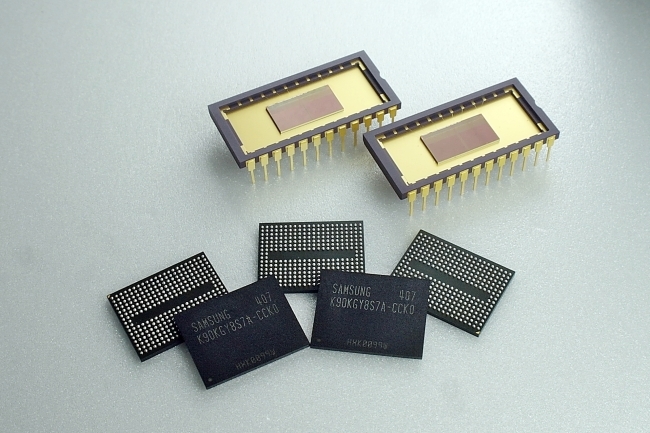[THE INVESTOR] Samsung Electronics has announced that it would shift its focus to NAND flash memory from DRAM as the global DRAM market is reeling from record low prices.
“The tech giant told investors (at the firm’s investor relations session) that it would scale down the investment in its DRAM business compared to last year,” reported online news outlet the Financial News, quoting a market analyst who participated in the meeting as saying.
The tech giant held IR sessions in New York City and Boston from June 14 to 16, trying to entice global investors.
DRAM has long been one of the marquee businesses of the tech giant since 1992 when Samsung rolled out a 64M DRAM chip for the first time in the world.
Having launched the semiconductor business in 1974 after taking over chipmaker Korea Semiconductor it rolled out its first DRAM model with memory capacity of 64 kilobyte, which can contain half page of a newspaper, in 1983.
Samsung is now leading the global DRAM sector with its market share reaching 46.4 percent, according to research firm DRAMeXchange.
The participants in the IR sessions reportedly showed interest in the firm’s 3D NAND flash memory, organic light-emitting diode, and smartphone businesses as well.
As the first mover in the 3D NAND flash memory market, the tech behemoth has been dominating the market for the memory chip, which stacks cells vertically instead of aligning them on a planar surface.
Samsung topped the world’s NAND flash memory market as of December last year with a 33.6 percent market share followed by Toshiba of Japan with 18.6 percent, SanDisk of the US with 15.8 percent, Micron of the US with 13.9 percent. SK hynix and Intel came fifth and sixth with 10.1 percent and 8 percent market shares, respectively.
“The tech giant told investors (at the firm’s investor relations session) that it would scale down the investment in its DRAM business compared to last year,” reported online news outlet the Financial News, quoting a market analyst who participated in the meeting as saying.
The tech giant held IR sessions in New York City and Boston from June 14 to 16, trying to entice global investors.
DRAM has long been one of the marquee businesses of the tech giant since 1992 when Samsung rolled out a 64M DRAM chip for the first time in the world.
Having launched the semiconductor business in 1974 after taking over chipmaker Korea Semiconductor it rolled out its first DRAM model with memory capacity of 64 kilobyte, which can contain half page of a newspaper, in 1983.
Samsung is now leading the global DRAM sector with its market share reaching 46.4 percent, according to research firm DRAMeXchange.
The participants in the IR sessions reportedly showed interest in the firm’s 3D NAND flash memory, organic light-emitting diode, and smartphone businesses as well.
As the first mover in the 3D NAND flash memory market, the tech behemoth has been dominating the market for the memory chip, which stacks cells vertically instead of aligning them on a planar surface.
Samsung topped the world’s NAND flash memory market as of December last year with a 33.6 percent market share followed by Toshiba of Japan with 18.6 percent, SanDisk of the US with 15.8 percent, Micron of the US with 13.9 percent. SK hynix and Intel came fifth and sixth with 10.1 percent and 8 percent market shares, respectively.

After launching a memory chip with 24 layers of cells in 2013, Samsung is now working on scaling the 3D NAND memory to 64 layers and beyond.
Samsung explained to the participants that demand for solid state drives utilizing 3D NAND flash memories have been on the rise and the shift from hard disk drive to SSD in the sever and storage industries is picking up pace as the prices of SDDs are reaching a more affordable level than before.
Investors at the event paid a great deal of attention to flexible OLED as well, which will become a game changer in the smartphone market.
The smartphone equipped with a flexible OLED display becomes a tablet when fully unfolded. Samsung has developed and showcased a prototype of the foldable smartphone, and is pondering over the release date of the futuristic phone.
Some market analysts forecast that the firm will release the foldable phone as early as the first half next year.
“Expectations seemed high among investors for the foldable smartphone at the IR session,” Lee Se-chul, an analyst from NH Investment and Securities, was quoted as saying.
By Kim Young-won (wone0102@heraldcorp.com)









![[Today’s K-pop] BTS pop-up event to come to Seoul](http://res.heraldm.com/phpwas/restmb_idxmake.php?idx=644&simg=/content/image/2024/04/17/20240417050734_0.jpg&u=)
![[Graphic News] More Koreans say they plan long-distance trips this year](http://res.heraldm.com/phpwas/restmb_idxmake.php?idx=644&simg=/content/image/2024/04/17/20240417050828_0.gif&u=)






![[KH Explains] Hyundai's full hybrid edge to pay off amid slow transition to pure EVs](http://res.heraldm.com/phpwas/restmb_idxmake.php?idx=652&simg=/content/image/2024/04/18/20240418050645_0.jpg&u=20240419100350)

